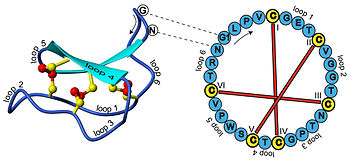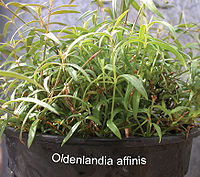- Cyclotides
-
Cyclotide family 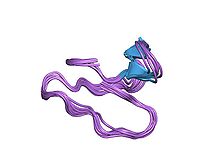
Structure of the uterotonic polypeptide kalata B1.[1] Identifiers Symbol Cyclotide Pfam PF03784 InterPro IPR005535 PROSITE PDOC51052 SCOP 1kal OPM protein 1bh4 Available protein structures: Pfam structures PDB RCSB PDB; PDBe PDBsum structure summary Cyclotides are small disulfide rich peptides isolated from plants[2]. Typically containing 28-37 amino acids, they are characterized by their head-to-tail cyclised peptide backbone and the interlocking arrangement of their three disulfide bonds. These combined features have been termed the cyclic cystine knot (CCK) motif (Figure 1). To date, over 100 cyclotides have been isolated and characterized from species of the Rubiaceae, Violaceae, and Cucurbitaceae families. Recently, cyclotides have also been identified in the Fabaceae or legumes, an agriculturally very important family [3][4][5].
Contents
Cyclotide structure
Cyclotides have a well-defined three-dimensional structure as a result of their interlocking disulfide bonds and cyclic peptide backbone. Backbone loops and selected residues are labeled on the structure to help orientation. The amino acid sequence (single letter amino acid representation) for this peptide is indicated on the sequence diagram to the right. One of the interesting features of cyclic peptides is that knowledge of the peptide sequence does not reveal the ancestral head and tail; knowledge of the gene sequence is required for this[6]. In the case of kalata B1 the indicated glycine (G) and asparagine (N) amino acids are the terminal residues that are linked in a peptide bond to cyclise the peptide.
Biological significance
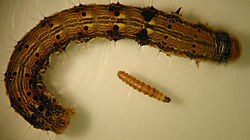 Figure 2. The stunting effect of kalata B1 on growth and development of Helicoverpa punctigera, a caterpillar from the Lepidopteran order.a
Figure 2. The stunting effect of kalata B1 on growth and development of Helicoverpa punctigera, a caterpillar from the Lepidopteran order.a
Cyclotides have been reported to have a wide range of biological activities, including anti-HIV, insecticidal, anti-tumour, antifouling, anti-microbial, hemolytic, neurotensin antagonism, trypsin inhibition, and uterotonic activities[7][8][9]. An ability to induce uterine contractions was what prompted the initial discovery of kalata B1[10].
The potent insecticidal activity of cyclotides kalata B1 and kalata B2 has prompted the belief that cyclotides act as plant host-defence agents (Figure 2). The observations that dozens or more cyclotides may be present in a single plant and the cyclotide architecture comprises a conserved core onto which a series of hypervariable loops is displayed suggest that, cyclotides may be able to target many pests/pathogens simultaneously.
A Serendipitous Discovery
 Kalata (2002) by Julian Voss-Andreae. The pictured sculpture is based on the atomic coordinates of kalata B1.[11]
Kalata (2002) by Julian Voss-Andreae. The pictured sculpture is based on the atomic coordinates of kalata B1.[11]
During a Red Cross relief mission in the Democratic Republic of Congo during the 1960s, a Norwegian doctor, Lorents Gran, noted that during labor African women used a medicinal tea made from the leaves of the plant Oldenlandia affinis (Figure 3) to induce labor and facilitate childbirth[12]. The active ingredient was later determined to be a peptide, named kalata B1, after the traditional name for the native medicine, kalata-kalata. Although in vivo studies in rats confirmed the uterotonic activity of the purified peptide, it was another 20 years before the cyclic cystine knot motif and structure of the purified peptide were elucidated[13].
Cyclotide amino-acid sequences
Analysis of the suite of known cyclotides reveals many sequence homologies that are important for understanding their unique physico-chemical properties and bioactivities. Table 1 presents a selection of cyclotides.
The cyclotides fall into two main structural subfamilies. Moebius cyclotides, the less common of the two, contain a cis-proline in loop 5 that induces a local 180º backbone twist (hence likening it to a Möbius strip, whereas bracelet cyclotides do not. There is smaller variation in sequences within these subfamilies than between them. A third subfamily of cyclotides are trypsin inhibitors and are more homologous to a family of non-cyclic trypsin inhibitors from squash plants known as knottins[14] than they are to the other cyclotides.
It is convenient to discuss sequences in terms of the backbone segments, or loops, between successive cysteine residues. The six cysteine residues are absolutely conserved throughout the cyclotide suite and presumably contribute to the preservation of the CCK motif. Although the cysteines appear essential to maintaining the overall fold, several other residues that are highly conserved in cyclotides are thought to provide additional stability[15].
Throughout the known cyclotides loop 1 is the most conserved. Apart from the six cysteine residues, the glutamic acid and serine/threonine residues of loop 1 are the only residues to have 100% identity across the bracelet and Möbius subfamilies. Furthermore the remaining residue of this loop exhibits only a conservative change i.e. glycine/alanine. This loop is believed to play an important role in stabilizing the cyclotide structure through hydrogen bonding with residues from loops 3 and 5.
Loops 2-6 also have highly conserved features, including the ubiquitous presence of just a single amino acid in loop 4 that is likely involved in sidechain-sidechain hydrogen bonding. Other conserved residues include a hydroxyl-containing residue in loop 3, a glycine residue in the final position of loop 3, a basic and a proline residue in the penultimate position in loop 5 of bracelet and Möbius cyclotides respectively, and an asparagine (or occasionally aspartic acid) residue at the putative cyclisation[6][16][17] point in loop 6. It is of interest to note that not only are certain residues highly conserved, but the backbone and side chain angles are as well.
With recent screening programs suggesting that the number of cyclotide sequences may soon reach the thousands[18], a database, CyBase, has been developed that offers the opportunity for comparisons of sequences and activity data for cyclotides. Several other families of circular proteins are known in bacteria, plants and animals and are also included in CyBase[19].
Biosynthesis of cyclotides
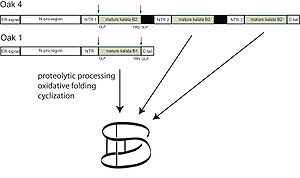 Figure 4. Schematic representation of the cyclotide precursors Oak1 and Oak4 and proposed mechanism of biosynthesis [20].
Figure 4. Schematic representation of the cyclotide precursors Oak1 and Oak4 and proposed mechanism of biosynthesis [20].
Plants are a rich source of cyclic peptides, with the vast majority of these molecules being produced via non-ribosomal biosynthetic pathways. In contrast, the cyclotides are gene-coded products generated via processing of a larger precursor protein[6]. The gene for the first such precursor is Oak1 (Oldenlandia affinis kalata clone number 1), which was shown to be responsible for the synthesis of kalata B1[16]. Figure 4 illustrates the generic configuration of the precursor protein, which consist of an endoplasmic reticulum signal sequence, a non-conserved pro-region, a highly conserved region known as the N-terminal repeat (NTR), the mature cyclotide domain and finally a short hydrophobic C-terminal tail. The cyclotide domain may contain either one cyclotide sequence, as in the case of Oak1, or multiple copies separated by additional NTR sequences as seen for Oak2 and Oak4. In precursor proteins containing multiple cyclotide domains these can either be all identical sequences, as is the case for Oak4, or they can be different cyclotides as in Oak2 which contains sequences corresponding to kalata B3 and B6.
Applications
The remarkable stability of cyclotides means that they have an exciting range of potential applications centred on either their intrinsic biological activities or the possibility of using the CCK motif as a scaffold for stabilizing biologically active epitopes[21]. Interest in these has recently intensified with the publications of a chemical methodology capable of synthetically producing cyclotides with high yields[22], and the amenability of the CCK framework to amino-acid substitutions[23]. But for molecules to be useful in a therapeutic setting they require useful biopharmaceutical characteristics such as resistance to proteolysis and membrane permeability. A recent study on related cystine knot proteins as drug candidates showed that cystine knots do permeate well through rat small intestinal mucosa relative to non-cystine knot peptide drugs such as insulin and bacitracin[24]. Furthermore, enzymatic digestion of cystine knot peptide drugs was associated with only a few proteases and it was suggested that this limitation may be overcome by mutating out particular cleavage sites. Thus, certain cystine knot proteins satisfy the basic criteria for drug delivery and represent exciting novel candidates as scaffolds for peptide drug delivery[24]. The diverse range of intrinsic activities of cyclotides also continues to hold promise for a wide range of applications in the agricultural fields.
Notes
a.^ A diet containing 0.8 μmol/g kalata B1 for 16 days significantly hindered development of caterpillar larvae compared with larvae on a diet free of kalata B1. Although no mortality was observed in the first six days for larvae fed the kalata B1 diet, 50% failed to survive past day sixteen. Those that did survive failed to progress pass the first instar stage of development and on average weighed 3.3 mg compared with larvae on the kalata B1 free diet that achieved fifth instar and weighed on average 284 mg [16]
References
- ^ Saether O, Craik DJ, Campbell ID, Sletten K, Juul J, Norman DG (April 1995). "Elucidation of the primary and three-dimensional structure of the uterotonic polypeptide kalata B1". Biochemistry 34 (13): 4147–58. doi:10.1021/bi00013a002. PMID 7703226.
- ^ Craik DJ, Daly NL, Bond T, Waine C (1999). "Plant cyclotides: A unique family of cyclic and knotted proteins that defines the cyclic cystine knot structural motif". J. Mol. Biol. 294 (5): 1327–36. doi:10.1006/jmbi.1999.3383. PMID 10600388.
- ^ Nguyen, Kien Truc Giang; Zhang, S., Nguyen, N. T., Nguyen, P. Q., Chiu, M. S., Hardjojo, A., Tam, J. P. (8). "Discovery and Characterization of Novel Cyclotides Originated from Chimeric Precursors Consisting of Albumin-1 Chain a and Cyclotide Domains in the Fabaceae Family". Journal of Biological Chemistry 286 (21–9258): 24275–24287. doi:10.1074/jbc.M111.229922. http://www.jbc.org/content/286/27/24275.abstract. Retrieved Jul 8 2011.
- ^ Poth AG, Colgrave ML, Philip R, Kerenga B, Daly NL, Anderson MA, Craik DJ (2011). "Discovery of Cyclotides in the Fabaceae Plant Family Provides New Insights into the Cyclization, Evolution, and Distribution of Circular Proteins". ACS Chemical Biology 6 (4): 345–355. doi:10.1021/cb100388j. PMID 21194241.
- ^ Poth AG, Colgrave ML, Lyons RE, Daly NL, Craik DJ (2011). "Discovery of an unusual biosynthetic origin for circular proteins in legumes". Proceedings of the National Academy of Sciences 108 (25): 10127–10132. doi:10.1073/pnas.1103660108. PMC 3121837. PMID 21593408. http://www.pubmedcentral.nih.gov/articlerender.fcgi?tool=pmcentrez&artid=3121837.
- ^ a b c Dutton JL, Renda RF, Waine C, et al. (2004). "Conserved structural and sequence elements implicated in the processing of gene-encoded circular proteins". J. Biol. Chem. 279 (45): 46858–67. doi:10.1074/jbc.M407421200. PMID 15328347.
- ^ Craik DJ, Daly NL, Mulvenna J, Plan MR, Trabi M (2004). "Discovery, structure and biological activities of the cyclotides". Curr. Protein Pept. Sci. 5 (5): 297–315. doi:10.2174/1389203043379512. PMID 15544527.
- ^ Göransson U, Sjögren M, Svangård E, Claeson P, Bohlin L (2004). "Reversible antifouling effect of the cyclotide cycloviolacin O2 against barnacles". J. Nat. Prod. 67 (8): 1287–90. doi:10.1021/np0499719. PMID 15332843.
- ^ Gustafson KR, McKee TC, Bokesch HR (2004). "Anti-HIV cyclotides". Curr. Protein Pept. Sci. 5 (5): 331–40. doi:10.2174/1389203043379468. PMID 15544529.
- ^ Gran L (1970). "An oxytocic principle found in Oldenlandia affinis DC An indigenous, Congolese drug kalata-kalataused to accelerate delivery". Medd. Nor. Farm. Selsk 32 (12): 173–80. http://www.popline.org/docs/0103/702847.html.[dead link]
- ^ Voss-Andreae, J (2005). "Protein Sculptures: Life's Building Blocks Inspire Art". Leonardo 38: 41–45. doi:10.1162/leon.2005.38.1.41.
- ^ Gran L, Sandberg F, Sletten K (2000). "Oldenlandia affinis (R&S) DC. A plant containing uteroactive peptides used in African traditional medicine". J Ethnopharmacol 70 (3): 197–203. doi:10.1016/S0378-8741(99)00175-0. PMID 10837983.
- ^ Saether O, Craik DJ, Campbell ID, Sletten K, Juul J, Norman DG (1995). "Elucidation of the primary and three-dimensional structure of the uterotonic polypeptide kalata B1". Biochemistry 34 (13): 4147–58. doi:10.1021/bi00013a002. PMID 7703226.
- ^ Chiche L, Heitz A, Gelly JC, et al. (2004). "Squash inhibitors: from structural motifs to macrocyclic knottins". Curr. Protein Pept. Sci. 5 (5): 341–349. doi:10.2174/1389203043379477. PMID 15551519.
- ^ Rosengren KJ, Daly NL, Plan MR, Waine C, Craik DJ (2003). "Twists, knots, and rings in proteins. Structural definition of the cyclotide framework". J. Biol. Chem. 278 (10): 8606–16. doi:10.1074/jbc.M211147200. PMID 12482868.
- ^ a b c Jennings C, West J, Waine C, Craik D, Anderson M (2001). "Biosynthesis and insecticidal properties of plant cyclotides: The cyclic knotted proteins from Oldenlandia affinis". Proc. Natl. Acad. Sci. U.S.A. 98 (19): 10614–9. doi:10.1073/pnas.191366898. PMC 58514. PMID 11535828. http://www.pubmedcentral.nih.gov/articlerender.fcgi?tool=pmcentrez&artid=58514.
- ^ Ireland DC, Colgrave ML, Nguyencong P, Daly NL, Craik DJ (2006). "Discovery and characterization of a linear cyclotide from Viola odorata: implications for the processing of circular proteins". J. Mol. Biol. 357 (5): 1522–35. doi:10.1016/j.jmb.2006.01.051. PMID 16488428.
- ^ Simonsen SM, Sando L, Ireland DC, et al. (2005). "A Continent of Plant Defense Peptide Diversity: Cyclotides in Australian Hybanthus (Violaceae)". Plant Cell 17 (11): 3176–89. doi:10.1105/tpc.105.034678. PMC 1276036. PMID 16199617. http://www.pubmedcentral.nih.gov/articlerender.fcgi?tool=pmcentrez&artid=1276036.
- ^ Craik DJ (2006). "Chemistry. Seamless proteins tie up their loose ends". Science 311 (5767): 1563–4. doi:10.1126/science.1125248. PMID 16543448.
- ^ Gruber CW, Cemazar M, Anderson MA, Craik DJ (2007). "Insecticidal plant cyclotides and related cystine knot toxins". Toxicon 49 (4): 561–75. doi:10.1016/j.toxicon.2006.11.018. PMID 17224167.
- ^ Craik DJ, Simonsen S, Daly NL (2002). "The cyclotides: novel macrocyclic peptides as scaffolds in drug design". Curr Opin Drug Discov Devel 5 (2): 251–60. PMID 11926131.
- ^ Gunasekera S, Daly NL, Anderson MA, Craik DJ (2006). "Chemical synthesis and biosynthesis of the cyclotide family of circular proteins". IUBMB Life 58 (9): 515–24. doi:10.1080/15216540600889532. PMID 17002979.
- ^ Craik DJ, Cemazar M, Daly NL (2006). "The cyclotides and related macrocyclic peptides as scaffolds in drug design". Curr Opin Drug Discov Devel 9 (2): 251–60. PMID 16566295.
- ^ a b Werle M, Schmitz T, Huang HL, Wentzel A, Kolmar H, Bernkop-Schnürch A (2006). "The potential of cystine-knot microproteins as novel pharmacophoric scaffolds in oral peptide drug delivery". J Drug Target 14 (3): 137–46. doi:10.1080/10611860600648254. PMID 16753827.
Further reading
- Shenkarev ZO, Nadezhdin KD, Sobol VA, Sobol AG, Skjeldal L, Arseniev AS (2006). "Conformation and mode of membrane interaction in cyclotides. Spatial structure of kalata B1 bound to a dodecylphosphocholine micelle". FEBS J. 273 (12): 2658–72. doi:10.1111/j.1742-4658.2006.05282.x. PMID 16817894.
- Sancheti H, Camarero JA (September 2009). ""Splicing up" drug discovery. Cell-based expression and screening of genetically-encoded libraries of backbone-cyclized polypeptides". Adv. Drug Deliv. Rev. 61 (11): 908–17. doi:10.1016/j.addr.2009.07.003. PMID 19628015.
See also
External links
- Cybase
- UMich Orientation of Proteins in Membranes families/superfamily-64 - Calculated orientations of cyclotides in membrane
Categories:- Peripheral membrane proteins
- Peptides
Wikimedia Foundation. 2010.

